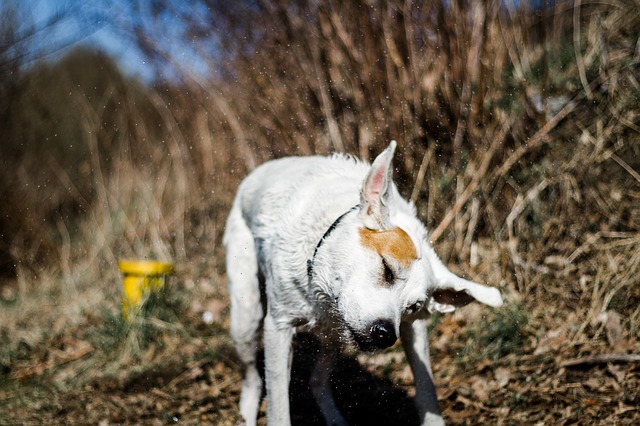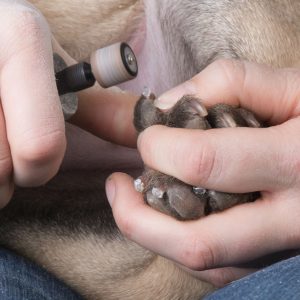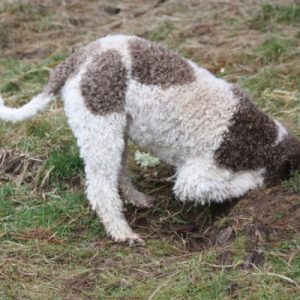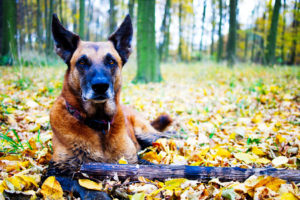Dogs have plenty of behaviors we may not always understand. And there’s doggie communication that’s mostly silent. So when you see your dog shaking their head throughout the day, you may wonder which category it falls into. Is your dog showing behavior you need to respond to? Or is it a kind of communication that only other dogs understand? And as that shaking goes on and on, when do you start getting worried? Some dog head shaking IS normal and okay. But other times, it’s a quiet cry that something’s wrong. And your favorite canine is asking for you to step in and make things better. We’ll explain the difference between the two and what to look for.
Shake, Rattle, and Roll
Plenty of dog breeds out there are clever. However, no canines possess fingers. That means whenever something goes wrong with their ears, they can’t reach them. And while a paw’s always handy, it may not do the trick. Even the best canine nails can’t reach into the ear canal. So what’s a poor dog to do?
They shake!
Dog head shaking allows them to “throw” out anything inside the ear that’s troubling them. And that shake’s POWERFUL. If you want to experience the power generated by a good dog head shake, sit next to a Basset Hound or other breed with long ears when they start up. You’ll feel the force as those ears smack you.
The prompt to shake comes from the hairs lining the inside of the ear. Those hairs detect the intrusion of foreign bodies (anything from dirt to water). When the hairs sense a problem, they create a “tickle” sensation. Determined to put a stop to that tickle, your dog immediately starts shaking their head. And with plenty of shakes, the dirt or water goes flying out.

Water Dogs
You often spot dog head shaking following a bath or a dip in the pool. Water LOVES going into the ear (as you know yourself). And getting all of the water out again is tricky. This is why it’s important NOT to pour water on your dog’s head when you’re bathing them. A thorough shake won’t get all of that liquid out – not on the first try, anyway.
Instead, you’ll see a slow trickle of water coming down from your dog’s ears. You can use a soft towel to collect the water as it leaks out. But it’s going to be a slow process. Your dog may shake their head for the remainder of the day as they try to work all of the fluid out of their ear canal. And, unfortunately, all of that water pulls earwax with it. This can create an odor on your dog’s fur (helpful, especially as you just finished a nice bath).
If you have a pup that loves swimming, you could battle constant head shaking. You don’t want to deprive them of their favorite hobby, but all of that water in the ear? It’s not healthy. Nor is so much dog head shaking (which we’ll get to in a minute). You can create a barrier between the pool (or your favorite body of water) and the ear by tucking half a cotton ball into your pup’s ears before you head out for the day. If your dog doesn’t tolerate that, talk to your vet about the best canine ear drying solutions. The solutions do exactly that: eliminating the water, so your poor canine isn’t shaking their head all night.
Dog Head Shaking
Dog head shaking is a common sight. It’s the equivalent of a scratch – but for the inner part of the ear. And as long as you only notice your dog doing so now and then, it’s nothing you need to worry about. Odds are they have a piece of grass, a little dirt, or (the usual culprit) water down there. It’s when you’re finding your dog shaking their head ALL the time that it presents a problem.
And there are multiple causes of dog head shaking. Some present more of a challenge than others, but all warrant a trip to the vet. Left untended, you can find yourself with a worsening ear problem. Hearing is the second most important canine sense. And while it may sound strange that a little head shake could lead to deafness, with the right combination of problems, that IS possible. Any time you notice frequent shakes, you want to take a peek in your dog’s ears. You may be dealing with one of these common medical issues:
- Allergies
- Infection
- Vasculitis
- Trauma
- Hematoma

Dog Head Shaking: Allergies
Allergies in dogs aren’t the most common health problem in the world. However, when allergies strike, they often lead to horrible itchy skin, pyoderma, and problems with the ears. And that itchy skin doesn’t confine itself to the OUTSIDE – it goes into that inner ear. So you see dog head shaking result. And when you look inside the ear, you’ll see plenty of red, irritated skin. You’ll also note your dog scratching at their face and chewing on their feet.
This is a good time to make an appointment with your vet and start allergy testing. Most canines have problems with something in their environment, especially plants outside. But you can also find sensitivity to mold spores, dust, and motes that lurk around the house. Your vet may prescribe an anti-histamine or even recommend a course of allergy injections to help manage things.
Our Greyhound is allergic to grass. But she also gets build-ups of earwax. So during the spring and summer, when we notice her shaking her head, we have to check her ears. Sometimes, everything’s clean (besides the occasional tell-tale piece of grass), and we know the shaking’s due to her insistence on rolling around on the lawn. Other times, we can see the wax and need to get out the cleaning supplies.
Dog Head Shaking: Otitis Externa
Ear infections are one of the biggest causes of dog head shaking. And otitis externa is the proper term for infections from the eardrum out to the ear flap. They can result from bacteria, yeast, OR both. And they make dogs MISERABLE. The infection generates discharge as those microbes grow and multiply. You’ll see AND smell it when you look in your dog’s ear. And with the discharge comes swelling and redness.
Dogs end up with ear infections from plenty of sources. Frequent bouts with allergies can cause infection. The body’s immune system isn’t working properly. Plus, all of that scratching (when the head shaking doesn’t work) brings dirty nails into the ear. And if your dog swims in water that isn’t pristine and clean? You got it – plenty of microbes. (And we already covered how difficult water removal is)
Ear infections require medical intervention. You don’t want to sit back and watch your dog’s head shaking for days on end. And, if you don’t get treatment, otitis externa can turn into otitis interna. When an infection gets past the eardrum, it’s dangerous. Your dog’s hearing gets put on the line.
Dog Head Shaking: Ear Vasculitis
Ear vasculitis is an uncommon sign of dog head shaking. What happens is the blood vessels in the ear flaps become inflamed, leading to skin problems. The irritation WILL cause your dog to shake their head due to the pain, but you won’t always see the scratching you might with allergies or an ear infection. Instead, you’ll notice:
- Reddish purple spots
- Crusts along the skin
- Fluid-filled cysts
- Hair loss around the ears
Vasculitis is more common in a few breeds, though it’s possible in ANY dog breed:
- Collie
- Dachshund
- German Shepherd
- Shetland Sheepdog
- Rottweiler
While certain conditions influence vasculitis, it’s usually driven by an autoimmune condition. You absolutely need to see a vet as soon as you notice the symptoms. They’ll start medications to calm down the immune system. Your dog may also need antibiotics if an infection has settled into the sores.

Bigger Concerns for Dog Head Shaking
While no one wants to see their dog uncomfortable, allergies, infection, and vasculitis ARE easy to manage with a vet’s care. You need to pick up on the signs of dog head shaking as soon as possible, of course. But once you know what’s going on, you can help ease the symptoms. And if you’re performing ear cleaning regularly, odds are you’ll notice changes as soon as they appear.
But there are a couple of more sinister reasons for why dogs shake their heads. And in the case of the hematoma, you may find yourself struggling with management if you don’t take care of one of these other problems FIRST.
Trauma
Dog head shaking can involve tiny pests you may not see in your regular checks. In certain regions, grass awns wreak havoc on dog ears. They’re sharp seeds from certain species of grass with the ability to burrow into the skin. Once an awn attaches to your dog’s ear, it continues to dig through the skin, making itself at home. And your poor pup is left with no way to alleviate the discomfort other than to shake. The awns need surgical removal.
And let’s not forget everyone’s favorite pest of the spring and summer months: biting insects. You hate them, and so does your dog. An insect bite on the ear may not show up until your dog’s scratching at it, creating a wound on the ear. Then they start head shaking to relieve the pain AND itch. It’s not a good combination.
Finally, some dog head shaking has nothing to do with the ears. Head injuries can result in problems with balance. While your dog may not understand their inner ear helps regulate their balance, they WILL shake their head to try to feel normal again. Always get to the vet for an evaluation if your dog suffers any head injury.
Aural Hematoma
Whenever dog head shaking is allowed to continue for long periods, you run the risk of developing an aural hematoma. This is when blood pools between the skin and the cartilage on the ear flap. You’ll see a swollen “bubble” on the ear. It’s painful and may change color, depending on how thick the hair is on your dog’s ear. And the cause? Head shaking and scratching.
Hematomas are DIFFICULT to manage. They WILL resolve on their own, but you need to stop the shaking that caused them in the first place. And that means addressing the underlying cause. Your vet can help you diagnose the infection, allergies, vasculitis, or other problem and start treatment. But to prevent the hematoma from getting worse, you have to stop your dog from shaking their head. (Yes, much easier said than done)
Some owners dislike the look of a hematoma. And the hematoma CAN get reduced. Some practices use a needle to drain the excess blood. Others require surgery. But until the shaking stops? The risk of a new hematoma forming remains. And recovery lasts for WEEKS. Your dog will need to wear an E-collar to prevent scratching. And you will need to stop them from shaking their head.

Let’s Shake Again
Dogs shake their heads. It’s the canine equivalent of a scratch for the inner ear. And when it only happens now and then? You don’t need to worry. Taking care around water activities will help even more. But when you’re seeing frequent dog head shaking, it’s time to pay attention. Your dog may have a serious medical condition that needs veterinary treatment – before an aural hematoma develops. Because dealing with a hematoma? That gets challenging.
So add a check on those ears to your daily routine. Your pup may not understand, but they’ll appreciate not having to shake so much. At least, not when they don’t want to.













No comment yet, add your voice below!